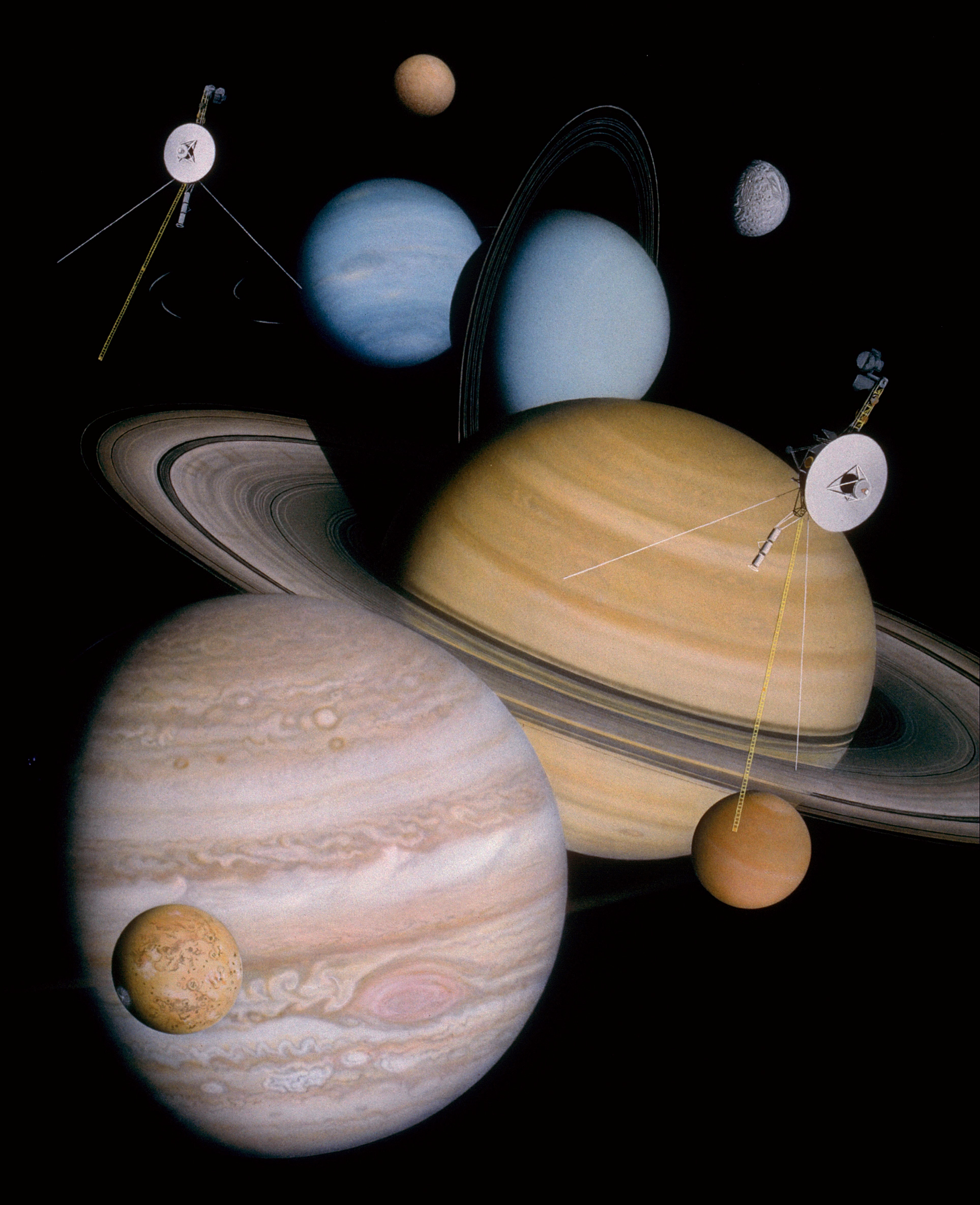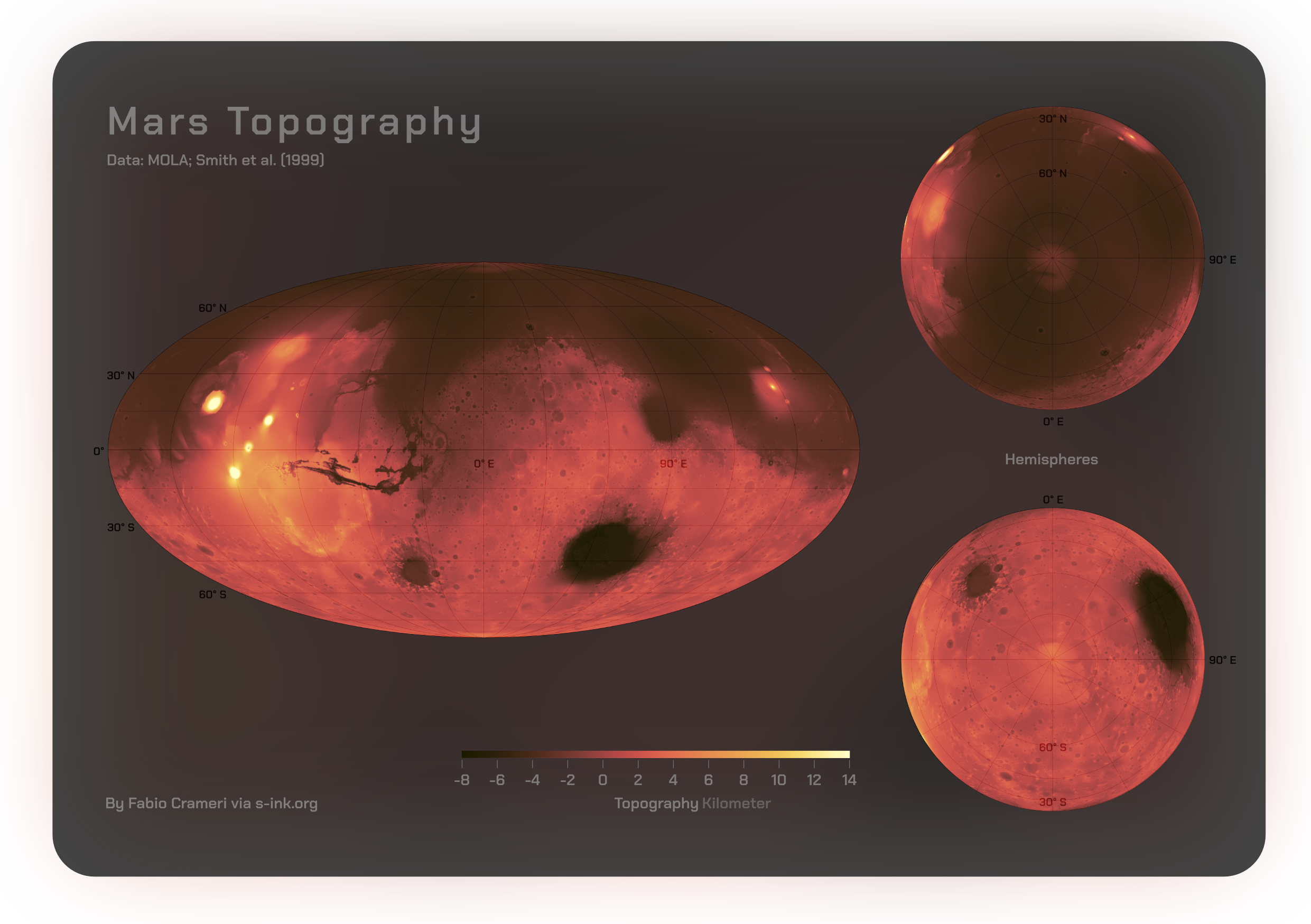|
Extraterrestrial Vortices
An extraterrestrial vortex is a vortex that occurs on planets and natural satellites other than Earth that have sufficient atmospheres. Most observed extraterrestrial vortices have been seen in large cyclones or anticyclones. However, occasional dust storms have been known to produce vortices on Mars and Titan. Various spacecraft missions have recorded evidence of past and present extraterrestrial vortices. The largest extraterrestrial vortices are found on the gas giants, Jupiter and Saturn; and the ice giants, Uranus and Neptune. Mercury Due to Mercury's thin atmosphere, it does not experience weather-like storms or other atmospheric weather phenomena such as clouds, winds, or rain. Rather unusually, Mercury has magnetic 'tornadoes' that were observed by NASA's Mercury MESSENGER during a flyby in 2008. The tornadoes are twisted bundles of magnetic fields that connect Mercury's magnetic field to space. Venus Venus Express observed two large shape-shifting vortices on Venus' ... [...More Info...] [...Related Items...] OR: [Wikipedia] [Google] [Baidu] |
Vortex
In fluid dynamics, a vortex (: vortices or vortexes) is a region in a fluid in which the flow revolves around an axis line, which may be straight or curved. Vortices form in stirred fluids, and may be observed in smoke rings, whirlpools in the wake of a boat, and the winds surrounding a tropical cyclone, tornado or dust devil. Vortices are a major component of turbulent flow. The distribution of velocity, vorticity (the curl of the flow velocity), as well as the concept of circulation are used to characterise vortices. In most vortices, the fluid flow velocity is greatest next to its axis and decreases in inverse proportion to the distance from the axis. In the absence of external forces, viscous friction within the fluid tends to organise the flow into a collection of irrotational vortices, possibly superimposed to larger-scale flows, including larger-scale vortices. Once formed, vortices can move, stretch, twist, and interact in complex ways. A moving vortex carries s ... [...More Info...] [...Related Items...] OR: [Wikipedia] [Google] [Baidu] |
Venus
Venus is the second planet from the Sun. It is often called Earth's "twin" or "sister" planet for having almost the same size and mass, and the closest orbit to Earth's. While both are rocky planets, Venus has an atmosphere much thicker and denser than Earth and any other rocky body in the Solar System. Its atmosphere is composed of mostly carbon dioxide (), with a global sulfuric acid cloud cover and no liquid water. At the mean surface level the atmosphere reaches a temperature of and a pressure 92 times greater than Earth's at sea level, turning the lowest layer of the atmosphere into a supercritical fluid. Venus is the third brightest object in Earth's sky, after the Moon and the Sun, and, like Mercury, appears always relatively close to the Sun, either as a "morning star" or an "evening star", resulting from orbiting closer ( inferior) to the Sun than Earth. The orbits of Venus and Earth make the two planets approach each other in synodic periods of 1.6 years ... [...More Info...] [...Related Items...] OR: [Wikipedia] [Google] [Baidu] |
Juno (spacecraft)
''Juno'' is a NASA space probe orbiting the planet Jupiter. Built by Lockheed Martin Space Systems, Lockheed Martin and operated by NASA Jet Propulsion Laboratory, the spacecraft was launched from Cape Canaveral Air Force Station on August 5, 2011 UTC, as part of the New Frontiers program. ''Juno'' entered a polar orbit of Jupiter on July 5, 2016, UTC, to begin a scientific investigation of the planet. After completing its mission, ''Juno'' was originally planned to be intentionally deorbited into Jupiter's atmosphere, but has since been approved to continue orbiting until contact is lost with the spacecraft. ''Juno'' mission is to measure Jupiter's composition, gravity field, gravitational field, magnetic field, and Magnetosphere of Jupiter, polar magnetosphere. It also searches for clues about how the planet formed, including whether it has a rocky core, the amount of water present within the deep atmosphere, mass distribution, and its deep winds, which can reach speeds up ... [...More Info...] [...Related Items...] OR: [Wikipedia] [Google] [Baidu] |
Cassini–Huygens
''Cassini–Huygens'' ( ), commonly called ''Cassini'', was a space research, space-research mission by NASA, the European Space Agency (ESA), and the Italian Space Agency (ASI) to send a space probe to study the planet Saturn and its system, including its Rings of Saturn, rings and Moons of Saturn, natural satellites. The Large Strategic Science Missions, Flagship-class robotic spacecraft comprised both NASA's ''Cassini'' space probe and ESA's Huygens (spacecraft), ''Huygens'' lander (spacecraft), lander, which landed on Saturn's largest moon, Titan (moon), Titan. ''Cassini'' was the fourth space probe to visit Saturn and the first to enter its orbit, where it stayed from 2004 to 2017. The two craft took their names from the astronomers Giovanni Cassini and Christiaan Huygens. Launched aboard a Titan IV, Titan IVB/Centaur on October 15, 1997, ''Cassini'' was active in space for nearly 20 years, spending its final 13 years orbiting Saturn and studying the planet and its system a ... [...More Info...] [...Related Items...] OR: [Wikipedia] [Google] [Baidu] |
Voyager Program
The Voyager program is an American scientific program that employs two interstellar probes, ''Voyager 1'' and ''Voyager 2''. They were launched in 1977 to take advantage of a favorable planetary alignment to explore the two gas giants Jupiter and Saturn and potentially also the ice giants, Uranus and Neptune—to Flyby (spaceflight), fly near them while collecting data for transmission back to Earth. After ''Voyager 1'' successfully completed its flyby of Saturn and its moon Titan (moon), Titan, it was decided to send ''Voyager 2'' on flybys of Uranus and Neptune. After the planetary flybys were complete, decisions were made to keep the probes in operation to explore Outer space, interstellar space and the outer regions of the Solar System. On 25 August 2012, data from ''Voyager 1'' indicated that it had entered interstellar space. On 5 November 2019, data from ''Voyager 2'' indicated that it also had entered interstellar space. On 4 November 2019, scientists reported that on ... [...More Info...] [...Related Items...] OR: [Wikipedia] [Google] [Baidu] |
Great Red Spot From Voyager 1
Great may refer to: Descriptions or measurements * Great, a relative measurement in physical space, see Size * Greatness, being divine, majestic, superior, majestic, or transcendent People * List of people known as "the Great" * Artel Great (born 1981), American actor * Great Osobor (born 2002), Spanish-born British basketball player Other uses * ''Great'' (1975 film), a British animated short about Isambard Kingdom Brunel * ''Great'' (2013 film), a German short film * Great (supermarket), a supermarket in Hong Kong * GReAT, Graph Rewriting and Transformation, a Model Transformation Language * Gang Resistance Education and Training, or GREAT, a school-based and police officer-instructed program * Global Research and Analysis Team (GReAT), a cybersecurity team at Kaspersky Lab *'' Great!'', a 2018 EP by Momoland *Great! TV, British TV channel group * ''The Great'' (TV series), an American comedy-drama See also * * * * * The Great (other) The Great is the moniker ... [...More Info...] [...Related Items...] OR: [Wikipedia] [Google] [Baidu] |
Polar Low
A polar low is a mesoscale, short-lived atmospheric low pressure system (depression) that is found over the ocean areas poleward of the main polar front in both the Northern and Southern Hemispheres, as well as the Sea of Japan. The systems usually have a horizontal length scale of less than and exist for no more than a couple of days. They are part of the larger class of mesoscale weather systems. Polar lows can be difficult to detect using conventional weather reports and are a hazard to high-latitude operations, such as shipping and gas and oil platforms. Polar lows have been referred to by many other terms, such as polar mesoscale vortex, Arctic hurricane, Arctic low, and cold air depression. Today the term is usually reserved for the more vigorous systems that have near-surface winds of at least 17 m/s (38 mph). History Polar lows were first identified on the meteorological satellite imagery that became available in the 1960s, which revealed many small-scal ... [...More Info...] [...Related Items...] OR: [Wikipedia] [Google] [Baidu] |
Poles Of Astronomical Bodies
The poles of astronomical bodies are determined based on their axis of rotation in relation to the celestial poles of the celestial sphere. Astronomical bodies include stars, planets, dwarf planets and small Solar System bodies such as comets and minor planets (e.g., asteroids), as well as natural satellites and minor-planet moons. Poles of rotation The International Astronomical Union (IAU) defines the north pole of a planet or any of its satellites in the Solar System as the planetary pole that is in the same celestial hemisphere, relative to the invariable plane of the Solar System, as Earth's north pole. This definition is independent of the object's direction of rotation about its axis. This implies that an object's direction of rotation, when viewed from above its north pole, may be either clockwise or counterclockwise. The direction of rotation exhibited by most objects in the solar system (including Sun and Earth) is counterclockwise. Venus rotates clockwise, and Ur ... [...More Info...] [...Related Items...] OR: [Wikipedia] [Google] [Baidu] |
Hubble Space Telescope
The Hubble Space Telescope (HST or Hubble) is a space telescope that was launched into low Earth orbit in 1990 and remains in operation. It was not the Orbiting Solar Observatory, first space telescope, but it is one of the largest and most versatile, renowned as a vital research tool and as a public relations boon for astronomy. The Hubble Space Telescope is named after astronomer Edwin Hubble and is one of NASA's Great Observatories program, Great Observatories. The Space Telescope Science Institute (STScI) selects Hubble's targets and processes the resulting data, while the Goddard Space Flight Center (GSFC) controls the spacecraft. Hubble features a mirror, and its five main instruments observe in the ultraviolet, visible spectrum, visible, and near-infrared regions of the electromagnetic spectrum. Hubble's orbit outside the distortion of atmosphere of Earth, Earth's atmosphere allows it to capture extremely high-resolution images with substantially lower background lig ... [...More Info...] [...Related Items...] OR: [Wikipedia] [Google] [Baidu] |
Mars Cyclone
Mars is the fourth planet from the Sun. It is also known as the "Red Planet", because of its orange-red appearance. Mars is a desert-like rocky planet with a tenuous carbon dioxide () atmosphere. At the average surface level the atmospheric pressure is a few thousandths of Earth's, atmospheric temperature ranges from and cosmic radiation is high. Mars retains some water, in the ground as well as thinly in the atmosphere, forming cirrus clouds, frost, larger polar regions of permafrost and ice caps (with seasonal snow), but no liquid surface water. Its surface gravity is roughly a third of Earth's or double that of the Moon. It is half as wide as Earth or twice the Moon, with a diameter of , and has a surface area the size of all the dry land of Earth. Fine dust is prevalent across the surface and the atmosphere, being picked up and spread at the low Martian gravity even by the weak wind of the tenuous atmosphere. The terrain of Mars roughly follows a north-south divide ... [...More Info...] [...Related Items...] OR: [Wikipedia] [Google] [Baidu] |








